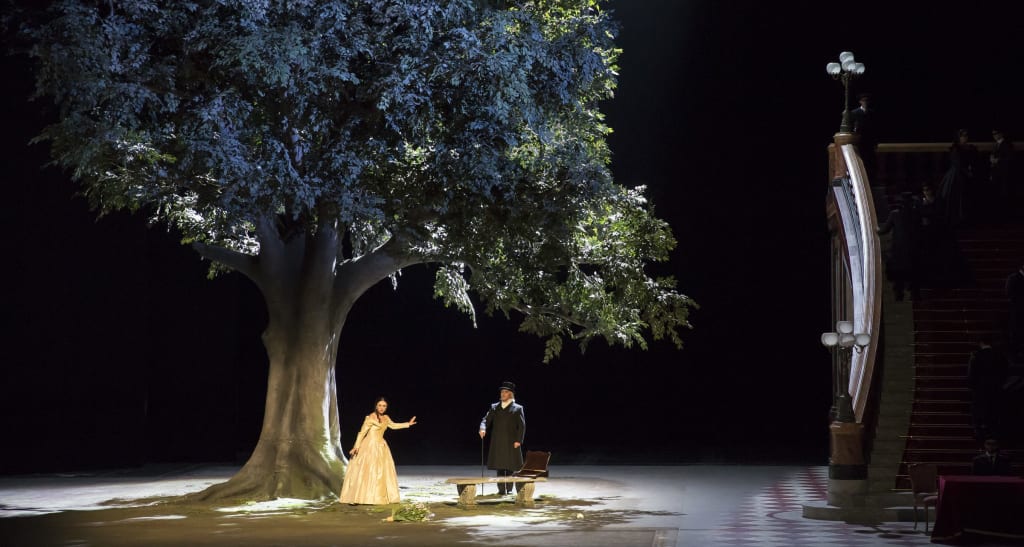Synopsis
"Farewell sweet, happy dreams of the past, the roses of my cheeks have already faded."- La Traviata, Act III, scene 1
Verdi was looking for “una donna di prima forza” to bring his Traviata to life. Augusta Albertini, for example, had she been available. Or Rosina Penco, whose beauty, expressiveness and stage presence predestined her for the title role. However, detained in Rome, she too was unable to accept the offer. Who else then? In his villa in Sant'Agata, the composer no longer concealed his doubts as to the success of his new opera – a fear compounded by the fact that the Teatro La Fenice in Venice had little better to offer him than Fanny Salvini-Donatelli. Although no longer “in the flower of her youth” and even less “an ideal beauty,” the singer kindled enthusiasm thanks to her one redeeming feature: her voice. However, that would not suffice to avoid the fiasco Verdi foresaw.
Violetta requires not one voice, but a miraculous combination of three: firstly, a soprano coloratura, virtuoso and brilliant; in addition, a voice sufficiently vibrant and lyrical to convey the burden of the sacrifice imposed by her lover's father, and lastly, one possessing a sense of the heart-rending drama amid the dying flames of the consumptive heroine’s last instants. The tragic actress turned tightrope walker sways unsteadily on a flimsy cord stretched to snapping point. Having sung Lucia di Lammermoor at the Bastille, Sonya Yoncheva has already demonstrated all these qualities. Now, for the first time in Paris, she is portraying Verdi’s fallen woman.
Duration : 3h05 with 2 intervals
Language : Italian
Artists
Opera in three acts (1853)
Creative team
Cast
Paris Opera Orchestra and Chorus
French and English surtitles
Media
Access and services
Opéra Bastille
Place de la Bastille
75012 Paris
Public transport
Underground Bastille (lignes 1, 5 et 8), Gare de Lyon (RER)
Bus 29, 69, 76, 86, 87, 91, N01, N02, N11, N16
Calculate my routeCar park
Parking Indigo Opéra Bastille 1 avenue Daumesnil 75012 Paris
Book your spot at a reduced priceIn both our venues, discounted tickets are sold at the box offices from 30 minutes before the show:
- €35 tickets for under-28s, unemployed people (with documentary proof less than 3 months old) and senior citizens over 65 with non-taxable income (proof of tax exemption for the current year required)
- €70 tickets for senior citizens over 65
Get samples of the operas and ballets at the Paris Opera gift shops: programmes, books, recordings, and also stationery, jewellery, shirts, homeware and honey from Paris Opera.
Opéra Bastille
- Open 1h before performances and until performances end
- Get in from within the theatre’s public areas
- For more information: +33 1 40 01 17 82
Online
Opéra Bastille
Place de la Bastille
75012 Paris
Public transport
Underground Bastille (lignes 1, 5 et 8), Gare de Lyon (RER)
Bus 29, 69, 76, 86, 87, 91, N01, N02, N11, N16
Calculate my routeCar park
Parking Indigo Opéra Bastille 1 avenue Daumesnil 75012 Paris
Book your spot at a reduced priceIn both our venues, discounted tickets are sold at the box offices from 30 minutes before the show:
- €35 tickets for under-28s, unemployed people (with documentary proof less than 3 months old) and senior citizens over 65 with non-taxable income (proof of tax exemption for the current year required)
- €70 tickets for senior citizens over 65
Get samples of the operas and ballets at the Paris Opera gift shops: programmes, books, recordings, and also stationery, jewellery, shirts, homeware and honey from Paris Opera.
Opéra Bastille
- Open 1h before performances and until performances end
- Get in from within the theatre’s public areas
- For more information: +33 1 40 01 17 82





























































